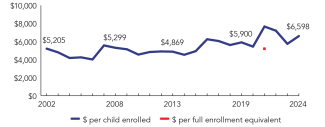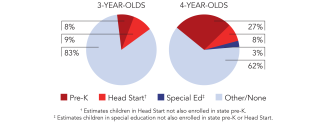
State of Preschool
Kentucky
Access Rankings
Resource Rankings
Total Benchmarks Met
Overview

During the 2023-2024 school year, Kentucky preschool enrolled 19,737 children, an increase of 214 from the prior year. State spending totaled $111,221,682, and an additional $18,996,470 in federal recovery funds supported the program, up $18,222,436 (16%), adjusted for inflation, since last year. State spending per child (including federal recovery funds) equaled $6,598 in 2023-2024, up $861 from 2022-2023, adjusted for inflation. Kentucky met 8 of 10 quality standards benchmarks.
What's New

The General Assembly included funding for full-day kindergarten and increased funding for the Child Care Assistance Program (CCAP). The General Assembly also passed House Bill 695, establishing the Adaptive Kindergarten Readiness Pilot Project. This initiative for Kentucky will provide new, no-cost, online educational experiences for preschool-aged learners who may not be attending state-funded preschool programs across the Commonwealth.
Implementation of the newly revised ALL STARS Quality program for Kentucky’s state-funded preschool classrooms began in the 2024-2025 school year. This program utilizes the TPOT observation tool and also incorporates components of the Pyramid Model Framework. This framework will encourage districts to implement best practices in classroom management and behavior. Components of the framework include, Benchmarks of Quality, Action Planning, Practice-Based Coaching, Trauma Informed Care, Positive Solutions for Families, Linking Early Literacy and Social Emotional Development, Prevent Teach Reinforce for Young Children (PTRYC), Targeted Strategies for Successful Inclusion of Children with Disabilities and Culturally Responsive Practices to Reduce Implicit Bias, Disproportionality, Suspension and Expulsion.
With support from the Governor’s Office of Early Childhood (GOEC) and Preschool Development Grant Development Birth through Five (PDG-5) funding, the Kentucky Department of Education (KDE) has awarded early childhood partnership grants to implement full-day, year-round, high-quality early care and education programs. Known as the Preschool Quality Partnership (PQP) grant, this initiative is implemented by 15 partnerships across the state starting during the 2024-2025 school year. A peer-to-peer coaching framework was developed to support partnership programs, focusing on program quality, early literacy, family engagement, early mathematics, and sustainability.
Background
The Kentucky Preschool Program (KPP), launched in 1990, is available to 4-year-olds from low-income families, and 3- and 4-year-olds with disabilities. KPP programs operate half- or full-day, for at least 2.5 hours per day, four or five days per week. Income eligibility increased from 150% to 160% FPL beginning with the 2015-2016 school year. Children who do not meet state eligibility requirements may still participate if there is space, but they are funded either by the school district or tuition rather than state dollars.
KPP is administered by the Kentucky Department of Education (KDE), Office of Special Education and Early Learning, the Early Learning Unit, School Readiness Branch. Funds are distributed to school districts through a funding formula. School districts may subcontract with private child care centers, Head Start programs, and special education providers to offer preschool services.
Kentucky Preschool Program
Access
Resources
| Total state pre-K spending | $130,218,152 |
| Local match required? | No |
| State Head Start spending | $0 |
| State spending per child enrolled | $6,598 |
| All reported spending per child enrolled* | $12,673 |

*Pre-K programs may receive additional funds from federal or local sources that are not included in this figure. †Head Start per-child spending includes funding only for 3- and 4-year-olds. ‡K–12 expenditures include capital spending as well as current operating expenditures.
Kentucky Quality Standards Checklist
| Policy | Requirement | Benchmark | Meets Benchmark? |
|---|---|---|---|
For more information about the benchmarks, see the Executive Summary and the Roadmap to State pages. | 8*benchmarks met | ||
| Early Learning & Development Standards Benchmark | Comprehensive, aligned, supported, culturally sensitive | Comprehensive, aligned, supported, culturally sensitive | |
| Curriculum Supports Benchmark | Approval process & supports | Approval process & supports | |
| Teacher Degree Benchmark | BA | BA | |
| Teacher Specialized Training Benchmark | ECE, CD, ECE SpEd | Specializing in pre-K | |
| Assistant Teacher Degree Benchmark | HSD or Equivalent | CDA or equivalent | |
| Staff Professional Development Benchmark | 24 hours/year (teachers); 18 hours/year (assistants); PD plans (public teachers only); Coaching (certified teachers) | For teachers & assistants: At least 15 hours/year; individual PD plans; coaching | |
| Maximum Class Size Benchmark | 20 (3- & 4-year-olds) | 20 or lower | |
| Staff to Child Ratio Benchmark | 1:10 (3- & 4-year-olds) | 1:10 or better | |
| Screening & Referral Benchmark | Vision, hearing, health & more | Vision, hearing & health screenings; & referral | |
| Continuous Quality Improvement System Benchmark | Structured classroom observations; Data used for program improvement* | Structured classroom observations; data used for program improvement | |
* Indicates that while policy meets the benchmark, it is not being implemented fully
